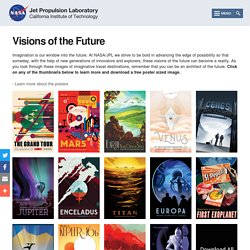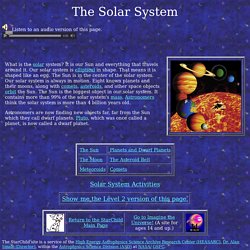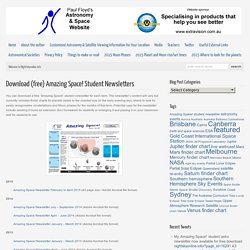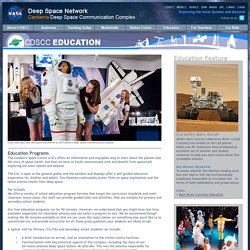

HowStuffWorks. Space for Kids - Free Games, Fun Facts, Cool Videos, Science Online. Visions of the Future. Imagination is our window into the future.

At NASA/JPL we strive to be bold in advancing the edge of possibility so that someday, with the help of new generations of innovators and explorers, these visions of the future can become a reality. As you look through these images of imaginative travel destinations, remember that you can be an architect of the future. Click on any of the thumbnails below to learn more and download a free poster sized image. › Learn more about the posters Can I get copies of these posters from NASA or JPL?
The immense power of the sun. How Neptune revolves around the sun. A long history of planet Mars. A long history of the Moon. Living on the moon! 00:00:00:00On-screen animation shows a house on the moon inside a dome with a sign that reads 'Home sweet home'.00:00:02:15On-screen text reads 'Living on the moon'.00:00:04:05Shot of Planet Earth in space covered in skyscrapers and dancing to music.00:00:12:09NARRATOR:We've lived on the Earth for a long time, and we've gotten pretty good at it.

In fact, we've gotten so good at it that we've started thinking about living somewhere else.00:00:21:15Shot of Mars in space with a sign that reads 'Mars Realty, 1.56 x 10 to the power of 15 sq ft! Earth rotation: night and day - Science (3,4,5,6,7,8) Solar system and space exploration. Pluto comes into focus. Voyage to the Planets. The atmospheres of the solar system. RussianSpaceWeb.com. For Students K-4. KS2 Science - Earth and the solar system. StarChild: The Solar System. StarChild: The Solar System. The Solar System Listen to an audio version of this page.

Solar System Activities The StarChild site is a service of the High Energy Astrophysics Science Archive Research Center (HEASARC), Dr. Alan Smale (Director), within the Astrophysics Science Division (ASD) at NASA/GSFC. Teacher Home Page - FUSE - Department of Education & Training. Eyewitness - Official Channel. Space for Kids. Curiosity Rover. Download (free) Amazing Space! Student Newsletters : Nightskyonline.info. You can download a free ‘Amazing Space!’

Student newsletter for each term. The newsletter’s content will vary but currently includes finder charts for planets visible to the unaided eye (in the early evening sky), where to look for easily recognisable constellations and Moon phases for the months of that term. Potential uses for the newsletter include sending it home as extension (fun) homework for students or enlarging it and placing it on your classroom wall for students to use. ESA. Solar System. Photojournal: NASA's Image Access Home Page.
Planetary Images. : Planets. Planets: The planet count in our solar system has gone as high as 15 before new discoveries prompted a fine tuning of the definition of a planet.

The most recent change was in 2006 when scientists reclassified Pluto as a new kind of object - a dwarf planet. Dwarf Planets: This new class of worlds helps us categorize objects that orbit the Sun but aren't quite the same as the rocky planets and gas giants in our solar system. There could be hundreds more of these small worlds far out there waiting to be discovered.
Canberra Deep Space Communication Complex - NASA's Deep Space Network. Come and make your own space discoveries at the Canberra Deep Space Communication Complex Education Programs The Canberra Space Centre (CSC) offers an informative and enjoyable way to learn about the planets and the story of space travel; and how we here on Earth communicate with and benefit from spacecraft exploring our Solar System and beyond.

The CSC is open to the general public and the exhibits and displays offer a self-guided education experience for children and adults. Two theatres continuously screen films on space exploration and the latest science results from deep space. For Schools We offer a variety of school education program formats that target the curriculum standards and meet classroom lesson plans. Our staff can provide guided talks and activities, that are suitable for primary and secondary school students. Our free education programs run for 90 minutes. Australia Telescope National Facility. NASA.